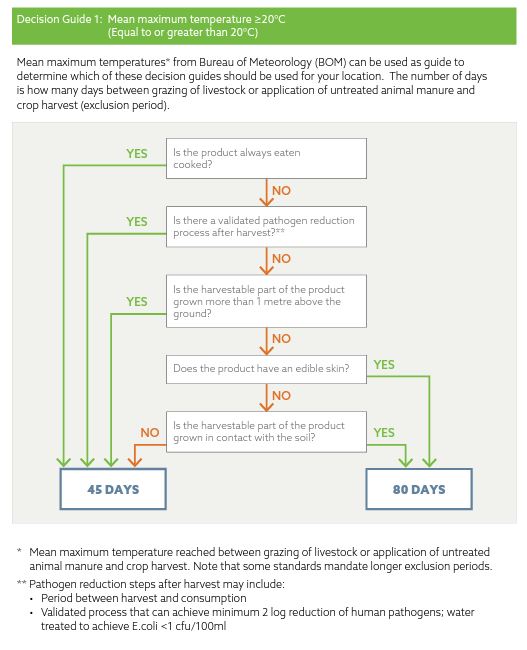Updated guidelines on the use of raw manures and withholding periods
The Fresh Produce Safety Centre Australia & New Zealand has recently updated its guidance regarding the use of raw animal manures in agricultural and horticultural production.
The Guidelines for Fresh Produce Food Safety 2022 Edition – Chapter 6 Managing fertilisers and soil additives.
Fertilisers and soil additives containing animal manure are not recommended for short-season crops, such as leafy vegetables and herbs.
Factors that need consideration when assessing risk from fertilisers and soil additives include the environmental temperature, the crop grown, the type of fertiliser or soil additive product used, how the product has been treated and where and how it is going to be used.
With untreated animal manures, pathogens can contaminate fresh produce by direct contact through the soil or on leaves, or indirectly through wind or water splash.
The advice regarding preventative steps remains the same:
- Avoiding the application of materials that contain untreated animal manure.
- Using only materials that have been treated to eliminate human pathogens.
- Further reduce risk to crops by incorporating manure into soil at the time of application.
- Applying an exclusion period between the application of the untreated material or grazing of livestock and crop harvest.
The advice regarding the length of recommended exclusion periods has been updated and is represented in two Decision Guides.
The exclusion periods shown in Decision Guides 1 and 2 provide general guidance as to minimum periods between grazing of livestock or application of untreated animal manure and harvest, based on the mean maximum (air) temperature* ranges where the crop is grown.
These exclusion periods are based on a review of the peer-reviewed literature, as this has shown that human pathogens die off more rapidly under warmer environmental conditions, and more slowly under cooler environmental conditions. Exclusion periods in Decision Guides 1 and 2 are based on the upper 99th percentile.
*Mean maximum temperatures from the Bureau of Meteorology (BOM) can be used as a guide to determine which of these decision guides should be used for your location.
You can find this information at http://www.bom.gov.au/climate/data/
The number of days is how many days between grazing of livestock or application of untreated animal manure and crop harvest (exclusion period).
Decision Guide 2: Mean maximum temperature <20°C
(Less than 20°C)

Reference – Guidelines for Fresh Produce Food Safety 2022, Page 29.
Example of how to use the Decision Guides
Example 1
Refer to the Guidelines for Fresh Produce Food Safety 2022, Page 31
Grower Jane grows spinach in Camden. She plants her autumn crop in early April, with harvest expected in May. She would like to apply untreated chicken manure to her crop. To determine what exclusion periods apply to her situation, Jane must first work out which Decision Guide applies to her.
To do this, she must first work out the mean maximum (air) temperature for April and May. She checks the BOM website and notes that the monthly mean temperature for Camden airport (her closest site) is 23.6°C for April and 20.3°C for May. Based on this data, she must refer to Decision Guide 1 as the mean maximum temperature for her growing area is greater than or equal to 20°C.
Working through the questions in Decision Guide 1, she establishes the following:
- Is the product always eaten cooked? No, she knows spinach is often eaten raw.
- Is there a pathogen reduction step after harvest? No, she knows that it’s important to get the harvest to the processor quickly, and that there’s no ‘kill step’ used for spinach.
- Is the harvestable part of the product grown above the ground (typically more than 1 metre)? No, spinach is grown close to the ground.
- Does the product have an edible skin? No, although it is edible, it’s not an edible skin, like what an apple or pear has.
- Is the harvestable part of the product grown in contact with the soil? Yes, the spinach is grown in the soil and often has soil that needs removing from the leaves.
Result = 80 day exclusion period.
An 80-day exclusion period means that Jane must not apply raw (untreated) manure or have animals graze on her land where she plans to grow the spinach for at least 80 days prior to her crop harvest. As she plans to harvest her crop around 30 May, she cannot apply raw manure at any point after 11 March (i.e. 80 days prior).


